Research
The Department of Earth and Environmental Sciences, with its wide and complementary range of faculty disciplinary expertise, prepares students for successful careers in environmental and geosciences in New York City and beyond through engagement in high impact academic training and cutting-edge research.
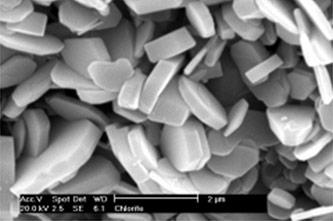
Fe chlorite (©Mineralogical Society)
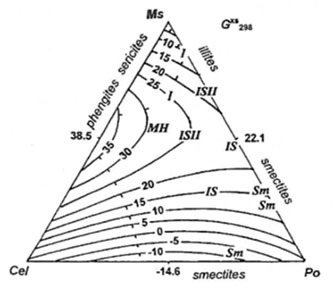
Excess Gibbs energy of mixing (kJ/mol) for pyrophyllite-celadonite-muscovite regular solid solution model of illite; MH, composition of Marblehead illite (Kulik and Aja, 1997).
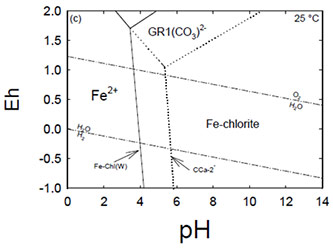
Eh-pH stability relationships between Fe chlorite and green rusts at 25 °C (Aja, 2019).
Stephen Aja
Low Temperature Geochemistry / Clay Mineralogy
Our research activities deal with various aspects of the thermodynamics of clay mineral-water interactions. Clay minerals (such as illite, chlorite) constitute a significant component of minerals of the sedimentary sequence and of hydrothermally-altered rock assemblages; clay transformations have direct application to hydrocarbon reservoir quality issues, to issues of carbon sequestration in geologic formations and to the formation of some ore minerals. The recent discovery of the existence of hydrous silicates including clay minerals on the surface of Mars intersects with our research interests in defining the thermodynamic stabilities of clay minerals under various physicochemical conditions. Other areas of our research interests include metal speciation in low-temperature hydrothermal systems, thermochemistry of zirconosilicates and theoretical models of the thermodynamic properties of minerals.
Rebecca Boger
Sustainability, Resilience, and Citizen Science
Working with multidisciplinary teams of researchers including local experts, archaeologists, anthropologists, geographers, and paleoclimate scientists, Associate Professor Boger is unraveling the story of the past, present, and potential future of Barbuda, a Small Island Developing State (SIDS) in the Caribbean. The particular research questions vary, but a common thread is an examination of long-term resilience and sustainability of the island and the people who have been living there. Boger's research contribution focuses on the use of geospatial technologies (GIS, GPS, and remote sensing) for environmental/climate modeling, archaeological surveying and community-based mapping. Her field tool kit includes a drone with thermal and RGB cameras, precision GPS, and mobile survey apps. Her lab is a computer with ArcGIS products, AgiSoft, and other software programs. Barbuda had a direct hit by Category 5 Hurricane Irma in 2017, which had a strong impact on the social and environmental systems. The story of Barbuda unfolds as we see how external social forces and climate change impact the island and Barbudans.
Additionally, Boger works with NASA GO (GLOBE Observer) and GLOBE scientists on the development and testing of citizen science protocols and apps. She is examining the data quality, usability, and visualization of GO and GLOBE data for citizen and professional (e.g., NASA) scientists. The participation of citizen scientists has grown dramatically over the last 10 to 20 years as well the different projects around the world. A challenge is how to bring related projects and datasets together to increase the potential science contributions. Boger and her team representing different mosquito citizen science projects are working toward integration and making the data available through the UNEP live portal. Their work with mosquitoes has led to an exciting nascent interdisciplinary research project that combines methods in social and environmental sciences to identify social and physical features of neighborhoods that put residents at higher risk of contracting mosquito-borne illnesses in New York City.
Boger's research is supported by funding from NSF, NASA, and CUNY. If you are interested in doing research in this area, please contact Associate Professor Boger via e-mail.
John Chamberlain
Paleobiology
Professor Chamberlain's research focuses on three separate projects:
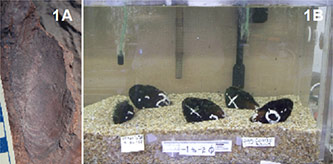
Fossil and modern freshwater bivalves dealt with in this project. 1A: Archanodon catskillensis from the Duncannon Member of the Catskill Formation, Steam Valley, PA. 1B: live Pyganodon cataracta from Willowbrook Pond, Staten Island, in life position in the College of Staten Island Aquarium Lab.
The extinction of the Devonian bivalve Archanodon catskillensis.
Chamberlain's aim is to show that the extinction of this earliest known freshwater bivalve is a consequence of predation by fish-amphibian transitional vertebrates, which appear in the fossil record as A. catskillensis drops out. His approach is to examine the predator avoidance strategies used by modern Pyganodon cataracta, a local freshwater bivalve morphologically similar to A. catskillensis, as a guide for interpreting predation pressure in its Devonian antecedent.
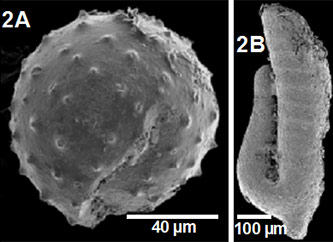
SEM images of Tully Formation microfossils. 2A: Solisphaeridium, an acritarch common in the Devonian of the Appalachian Seaway but of uncertain affinity. May be an alga. 2B: Jinonicella kolebabai, an animal of unknown affinities. The Tully specimens are the only known occurrences of microfossil in North America.
The microbiota of the Devonian Tully Formation of New York and Pennsylvania.
The age of the Tully Formation places it just prior to the onset of the Taghanic Biocrisis, an event that restructured the marine fauna of North America through extinction of many endemic North American animal lineages due to immigration of European lineages into North America. This project aims to determine whether the phytoplankton at the base of the Devonian marine food chain were also replaced by invasive phytoplanktonic species from elsewhere in the Devonian ocean. The Tully work is intended to establish the taxonomic composition of the phytoplankton and to elucidate other microorganisms present in the Appalachian Seaway just before the onset of the Taghanic Biocrisis.
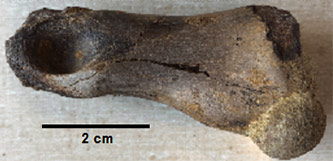
Theropod toe bone found in the Late Cretaceous Fairpoint Member of the Fox Hills FM, White Owl, SD.
Taxonomic identification of a Late Cretaceous theropod toe bone.
The toe bone figured here is from the right foot of a theropod dinosaur. Likely candidates include juveniles of large tyrannosaurids, or adults of smaller forms, such as deinonychosaurs and ornithomimids. The robustness of the bone suggests a tyrannosaurid. The bone was collected from near-shore marine sandstones at a locality from which we have taken thousands of shark teeth. However, the bone, shows no sign of shark bite marks or long exposure on the seafloor, nor was other dinosaur material associated with the specimen.
Professor Chamberlain's research is supported by funding from PSC-CUNY. If you are interested in doing research in this area, contact Professor Chamberlain via e-mail.
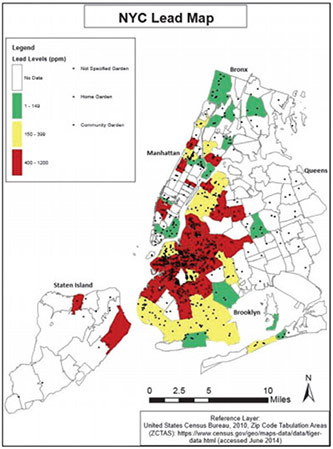
Figure: Distribution of gardens where the soil samples were collected for this study. This map includes 904 identifiable street addresses for the gardens, and each dot on the map represents a garden. Each polygon on the map represents a zip code. Each zip code is color coded based on median Pb concentration, except for zip codes with fewer than five samples.
Zhongqi (Joshua) Cheng
Environmental Geochemistry, Urban Soils, Urban Sustainability
Professor Zhongqi (Joshua) Cheng is director of the Environmental Sciences Analytical Center (ESAC, including the Urban Soils Lab) at Brooklyn College, and a faculty member for the Earth and Environmental Sciences Ph.D. Program at the CUNY Graduate Center and the Macaulay Honors College. He is an associate editor for the Journal of Environmental Quality. Cheng is co-founder of the NYC Urban Soils Institute, member of the Healthy Soils Heathy Communities Project and the Legacy Lead Coalition. Cheng explores a number of urban environmental sustainability issues and aims to find green and sustainable solutions for challenging environmental issues in cities. His research integrates field monitoring, lab analysis, and experiments as well as statistical analysis and computer modeling to study complex environmental problems, sometime coupled with studies on social dimensions. Most of his group's work revolves around urban soils and its roles in natural and human modified systems in New York City. He works closely with agencies and community organizations to carry out research projects. Currently the focus is on (1) lead (Pb) contamination in urban community gardens in New York City, (2) urban green infrastructure systems in New York City, and (3) beneficial use of biosolids.
Professor Cheng's research has been supported by USDA, NYC DEP, US EPA, and NSF. If you are interested in doing research in this area, contact Professor Cheng via e-mail.

An architectural rendering of J. Cherrier’s ecoWEIR technology applied to urban stormwater management.
Jennifer Cherrier
Aquatic Sciences and Water Resource Sustainability
Professor Cherrier's research focus is aquatic biogeochemistry with these efforts both basic and applied. Specifically, Cherrier evaluates transformations and fate of dissolved carbon and nitrogen in freshwater and marine systems and those factors that regulate microbial cycling and flux of these elements, particularly as it interacts with ecosystem dynamics and how it relates to global carbon budgets. Her approach traces carbon and nitrogen flow by coupling nutrient concentration measurements together with measurements of stable isotope and natural radiocarbon abundances. Over the past 15 years, she has also been evaluating how human stressors, especially stormwater runoff and sewage inputs, impact these biogeochemical cycles and in identifying natural solutions for offsetting these impacts to ensure the sustainability of our aquatic resources. To this end, her research group has developed a novel ecosystem-based hybrid technology (eco-WEIR, patented) that augments and "activates" green infrastructure to both maximize stormwater interception and pollutant removal efficiency as well as allow for water capture and reuse. Some examples of research her laboratory and collaborators have recently been engaged in include (1) decentralized ecosystem-based approaches for intercepting and mitigating pollutant loading into aquatic systems (fresh, marine, and surficial groundwater); 2) urban stormwater resiliency and integrated water management; 3) dissolved inorganic and organic nutrient supply/quality into aquatic systems and its affects on microbial cycling, flux and dynamics of carbon and nitrogen; 4) impacts nutrient inputs and microbial cycling on harmful algal bloom growth and toxin production, and strategies for mitigation; and 5) tracing carbon and nitrogen inputs (including contaminants such as oil) into aquatic systems and their flow into through microbial communities and into the food web
Professor Cherrier's research is supported by several funding agenicies including NSF, NOAA, the NYC DEP, and the State of New York. If you are interested in doing research in this area, contact Professor Cherrier via e-mail.
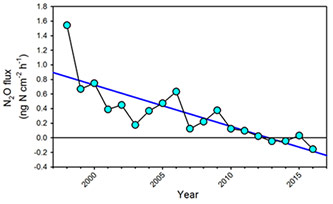
Long-term declines in soil to atmosphere flux of N2O flux from 1998 to 2016 at the Hubbard Brook Long Term Ecological Research site. Values are means of variable numbers of sites, sampled at variable frequency in different years along elevation gradients. Trend is statistically significant (r = -0.90, p < 0.001). From: Groffman, P.M., C.T. Driscoll, J. Durán, J.L. Campbell, L.M. Christenson, T.J. Fahey, M.C. Fisk, C. Fuss, G.E. Likens, G. Lovett, L. Rustad and P.H. Templer. 2018. Nitrogen oligotrophication in northern hardwood forests. Biogeochemistry: https://doi.org/10.1007/s10533-018-0445-y
Peter M. Groffman
Ecosystems, Soil, Landscape and Microbial Ecology, Carbon and Nitrogen Dynamics
Professor Peter M. Groffman is also a professor at the City University of New York Advanced Science Research Center and a senior research fellow at the Cary Institute of Ecosystem Studies. Groffman has research interests in ecosystem, soil, landscape, and microbial ecology, with a focus on carbon and nitrogen dynamics. He is chair of the Science Council of the U.S. National Science Foundation funded Long-Term Ecological Research (LTER) network and a participant in LTER projects in Baltimore (urban) and New Hampshire (northern hardwood forests). Specific recent research efforts include studies of nitrogen dynamics in urban watersheds, lawns, riparian zones and forests, winter climate change effects on nutrient cycling in forests, calcium/nitrogen/carbon interactions in forests, and the effects of exotic earthworm invasion on soil nitrogen and carbon cycling. Groffman was a Convening Lead Author for the 2013 U.S. National Climate Assessment Chapter on Ecosystems, Biodiversity and Ecosystem Services and a lead author for the Second (Wetlands) and Third (North America) Assessment Reports of the Intergovernmental Program on Climate Change (IPCC).
Professor Groffman's research is supported by grants from the U.S. National Science Foundation, NASA, and the USDA. If you are interested in doing research in this area, contact Professor Groffman via e-mail.
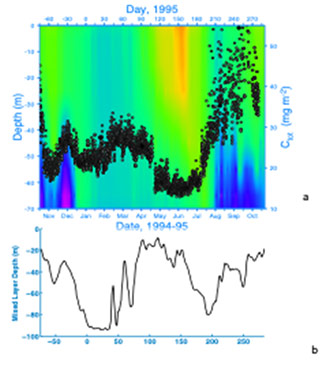
Figure Caption: (a) Contour plot of temperature overlain with areal chlorophyll-a (Ctot, mg m-2) from the mooring (open circles) and from shipboard hydrographic casts (filled circles), and (b) mixed layer depth. Mixed layer depths were estimated as a temperature difference of
0.1°C from the surface temperature.
John F. Marra
Biological Oceanography
Professor Marra's research involves ocean productivity: photosynthesis in the ocean, the first step in the ocean's food-web. Marra is interested in how ocean productivity is regulated by irradiance and physical processes in the ocean. As such, he has done research on productivity at ocean frontal systems, the causes of the spring phytoplankton outburst (bloom) in the North Atlantic, upwelling in the Banda Sea (Indonesia), and temporal variability in the Arabian Sea, as governed by the Asian monsoon. He is also interested in how ocean optical properties affect ocean productivity. There are interesting feedbacks among surface irradiance, the depth to which irradiance penetrates the ocean, its absorption by phytoplankton pigments, and the efficiency with which irradiance is utilized to fix inorganic carbon into phytoplankton biomass. Marra also investigates phytoplankton respiration, a very difficult parameter to measure in natural populations. As director of AREAC, he is interested in promoting the science of aquaculture, and introducing new marine species to domestication.
Professor Marra's research has been supported by funding from NSF, the Department of the Interior, and NASA. If you are interested in doing research in this area, contact Professor Marra via e-mail.
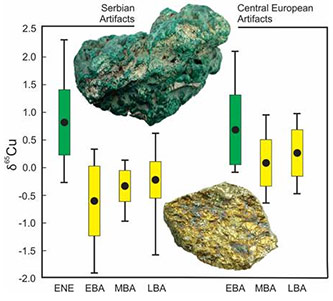
Diachronous transition from oxide-based to sulfide-based copper smelting in Serbia (Early Bronze Age) and Central Europe (Middle Bronze Age), as delineated by δ65Cu.
Wayne Powell
Mining and Mineral Resources: Past and Present
The discovery and adoption of metallurgy approximately 7,000 years ago was a transformative step in human cultural evolution, initiating the trend toward urbanization and broad scale trade. Three milestones in the mastery of minerals and metals were humanity's ability to: 1) smelt copper from the oxidized mineral malachite, 2) smelt copper from the sulfide mineral chalcopyrite, and 3) smelt tin from cassiterite for the production of bronze, the alloy of copper and tin. When were these pyrotechnological discoveries made? How and when did such technology diffuse across Europe? What were the sources of ancient ores, and what was the nature and extent of trade networks for rare metals? Nontraditional isotope systems (Sn, Cu, Ag) provide a means by which these questions may be answered. With the cooperation of museums and archaeological institutes in Serbia, Bosnia, Bulgaria, Romania, Turkey, Slovenia, Hungary, Austria, and the Czech Republic, Professor Powell is are identifying isotopically distinct metal sources, delineating their trade over thousands of kilometers, and tracking the diffusion of pyrotechnology across Europe. In addition, Powell's research group studies the processes that form and reform present-day ore deposits in the United States, Europe, and China, and how nontraditional isotopes provide insights into the associated geological mechanisms.
Professor Powell's research is supported by the Institute for Aegean Prehistory (INSTAP), the Chinese Academy of Science, and the PSC-CUNY Research Grant program. If you are interested in doing research in mineral resources or archaeometallurgy, contact Professor Powell via e-mail.






